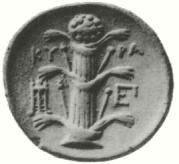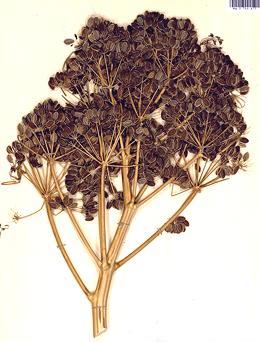Silphium / Laser
 [Laser (Rome), Silphium (Greece), Ferula ?????]
[Laser (Rome), Silphium (Greece), Ferula ?????]
This plant, apparently a giant fennel, provided several of the most
important sauces and condiments of ancient Greece and Rome, as well as
medicinals there and in Egypt. Juice from the stems and roots, the stems
themselves and most important the resin exuded from cuts just above the
root were used. So important was this plant to the ancient cuisines they
cannot be accurately reproduced without it. Unfortunately it is not
currently available due to presumed extinction (some still hope it can be
found somewhere in the wilds of Libya).
While other members of the fennel family have been sold as "silphium",
true silphium grew only around the city of Cyrene in Libya, North Africa.
While Pliny wrote that silphium of Cyrene was extinct in the 1st century
CE, it appears from other writers it still existed there in the 5th
century CE, but they may have mistaken another fennel for it. Several
varieties of African fennel have been proposed as "silphium" but all
ancient representations of the plant distinctly show a striated stem
and leaf petioles in nearly opposite pairs. No fennel like this has yet been
found. Ferula tingitana is thought to be the nearest living
relative. Photo of coin from Cyrene believed in the
public domain.
More on Fennels.
Greek and Roman writers did not describe silphium's taste
characteristics in detail - everyone already knew them. What we do know
is that Asafoetida, available with
somewhat different characteristics from various regions, was considered
inferior to true silphium. In particular silphium did not have the
sulphurous odor asafoetida has. This is, however, a point of similarity
we can work from. Since asafoetida is as close as we can get today, it is
good that the unmistakable smell of SAE 90 weight hypoid gear oil
disappears if the resin is properly fried in hot oil for just a few
seconds before adding other ingredients.
Other parts of the plant were also used but are now unavailable except
in Persia and Afghanistan where asafoetida is grown. I have developed a
recipe, Laser Root / Stem /
Juice to fake up a substitute.
Silphium Found?
 The Giant Fennel Ferula drudeana has been found in three locations in
Turkey which were, until recently, Greek villages. It matches every reliable
description of Silphium, including striated stalks, nearly opposed leaves
with stem sheaths, and thick ginseng-like root, characteristics not found in
other Fennels. It is also very aromatic and contains a large number of
medicinal substances, much more than any other Fennel. As testified in Roman
literature, it does not have the sulphuric smell of asafoetida which became
the substitute for Laser. Culinary testing has begun, based on ancient Roman
recipes which call for Laser (Roman for Silphium).
The Giant Fennel Ferula drudeana has been found in three locations in
Turkey which were, until recently, Greek villages. It matches every reliable
description of Silphium, including striated stalks, nearly opposed leaves
with stem sheaths, and thick ginseng-like root, characteristics not found in
other Fennels. It is also very aromatic and contains a large number of
medicinal substances, much more than any other Fennel. As testified in Roman
literature, it does not have the sulphuric smell of asafoetida which became
the substitute for Laser. Culinary testing has begun, based on ancient Roman
recipes which call for Laser (Roman for Silphium).
In ancient times, attempts to transplant Silphium from Lybia to Greece
had failed, but perhaps Greek people of these villages took seeds there and
they did become naturalized. Modern research confirms that this Fennel is
very difficult to grow anywhere, and especially away from its Turkish
locations, but it has now been done. Parts of California might be good
locations for this plant.
Despite the above, identification of this plant as Silphium is quite
controversial, as fennel species are quite variable. The exact lineage of this
plant has yet to be determined, and most objections are geographic. On the
other hand, whether it is the ancient Silphium or not, it is by far closer
than any other plant we have, so cultivating it would be a good idea.
Unfortunately I found no photos of living plants that are under Creative
Commons or Public Domain, so the photo here is from the Moscow Digital
Herbarium distributed under license Creative Commons
Attribution Share-alike v4.0 International.
py_silphz 081018 r 240414 - www.clovegarden.com
©Andrew Grygus - agryg@clovegarden.com - Photos on this
page not otherwise credited are © cg1 -
Linking to and non-commercial use of this page permitted
 The Giant Fennel Ferula drudeana has been found in three locations in
Turkey which were, until recently, Greek villages. It matches every reliable
description of Silphium, including striated stalks, nearly opposed leaves
with stem sheaths, and thick ginseng-like root, characteristics not found in
other Fennels. It is also very aromatic and contains a large number of
medicinal substances, much more than any other Fennel. As testified in Roman
literature, it does not have the sulphuric smell of asafoetida which became
the substitute for Laser. Culinary testing has begun, based on ancient Roman
recipes which call for Laser (Roman for Silphium).
The Giant Fennel Ferula drudeana has been found in three locations in
Turkey which were, until recently, Greek villages. It matches every reliable
description of Silphium, including striated stalks, nearly opposed leaves
with stem sheaths, and thick ginseng-like root, characteristics not found in
other Fennels. It is also very aromatic and contains a large number of
medicinal substances, much more than any other Fennel. As testified in Roman
literature, it does not have the sulphuric smell of asafoetida which became
the substitute for Laser. Culinary testing has begun, based on ancient Roman
recipes which call for Laser (Roman for Silphium).  [Laser (Rome), Silphium (Greece), Ferula ?????]
[Laser (Rome), Silphium (Greece), Ferula ?????]